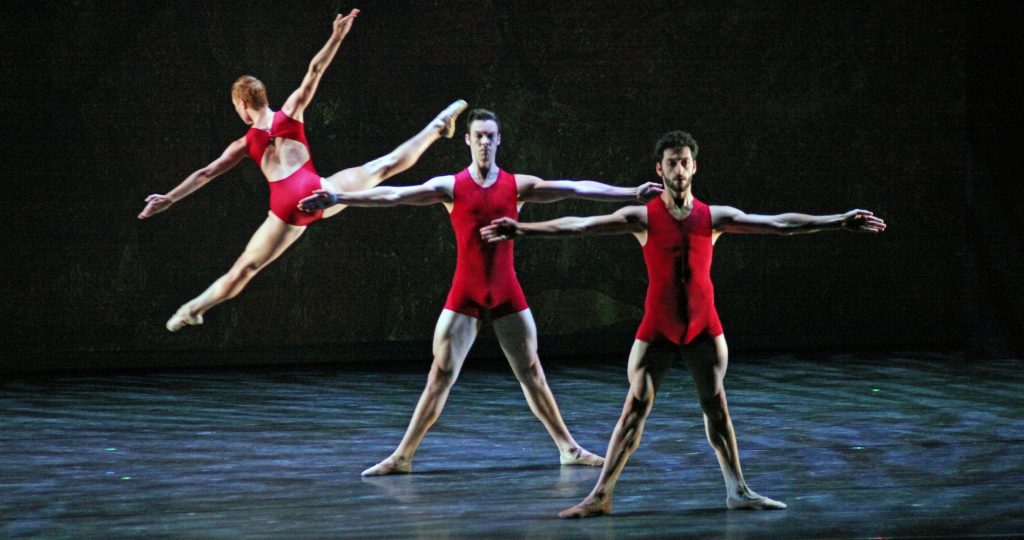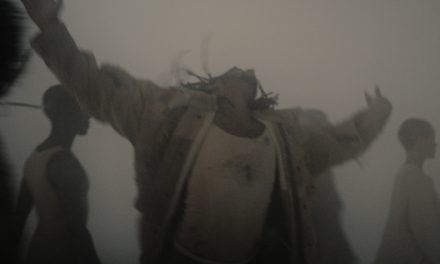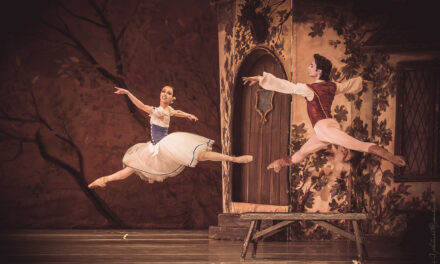Saturday, July 28th’s Raiford Rogers Modern Ballet performance lit up CSULA’s Luckman Fine Arts Complex stage with two pieces full of expert dancing, vivid painting animations and rich soundscapes. Though the company’s signature movements could be seen throughout both ballet works, there was a distinct difference in tone that was enhanced by the dancers’ technical finesse. Strong solos and well-synchronized pas de deuxes demonstrated their prowess through their ability to make the choreography appear deceptively simple.
The show opened with last year’s premiere, Joshua Tree Symphony, set to Czech composer Zbynek Mateju’s composition of the same name. Painter Mike Nava provided the background art that accompanied the piece—images of craggily rocks covered in red and other earth-toned paint that appeared to drip and bleed as the dancing and music progressed. The photographs faded into each other throughout the ballet in an unending loop.
The evening began with slow développés that invoked the feeling of rousing stretches as the dancers tuned their bodies to the music. Clinking bells however soon became accompanied by scratchy violin sounds that changed the tone to that of a creepy horror film enhanced by the growing red hue seen in the backdrop. The dancers performed mostly in duets that entered and exited the stage from all sides in bursts, quickening their movements to stay in sync with the music’s rising pitch as it built up to electrifying heights.
Breaking the drama were light, tingling echoes of chimes that saw soloists like Hannah Keene take center stage and perform routines with steady turns reminiscent of music box ballerinas. The uneven soundtrack would then transition into brass crescendos that encouraged large and elongated movements, which much like the earthy projections, literally grounded the dancers as they performed grand pliés and low cambrés. These adagios, often performed by duos who would prolong the steps by then lunging their upper bodies forward while holding each other’s hands, became the most distinctive in the entire ballet. These slow, heavy patterns would be broken up by all the dancers then skipping back onto the stage to spin and pirouette alone in chaotic circles, their arms extended outward or upward before they inevitably coupled off again to repeat the pattern.
The choreography almost seemed mathematical with its recurring phrases, yet still demonstrated artistic flair, the dancers breaking the straight lines they formed with their strict stances and tall silhouettes by bending their bodies into curving angles.
After a brief intermission, the company launched its world premiere of Naiveté of Flowers, a tribute to late composer Lloyd Rodgers (1942-2016). The same 13 performed to selections from Rodgers’ 1986 ballet The Little Prince and alongside another one of Nava’s painting progressions—this time abstract, flowers in yellow, orange, white and blue.
The dancers’ approach to the movement starkly contrasted the ominous routine seen in Joshua Tree Symphony. Though some of the motions were quite similar, namely the long lines and gradual expanding extensions of the arms and legs, there was an overall delicate feel that replaced the sternness seen in the previous piece.
Xylophones and light percussion instruments accompanied by airy strings created an innocent and gentle quality seen in the dancers’ spins, especially at their completion when they drew-out their bodies upward like growing flowers before flowing into their next acts. Jovial clinging tones brought on open-armed, circular port de bras, which made the dancers look like windmills turning in the breeze.
Two pas de deuxes performed side-by-side by Chelsea Paige Johnston and Gustavo Barros, and Elisabeth Walker and Bobby Briscoe created a different scene altogether. The strong partnerships were characterized by the men maneuvering their partners over their shoulders in short lifts, which resulted in the women’s legs and feet rising above their heads. The duets ended with Johnston and Walker facing Barros and Briscoe as they formed an “X” with their bodies, their arms and legs jutting outward before they bent their knees inward to touch their ankles together—a memorable pose that resulted in a geometric throwback to some of the more angular moves seen in the previous piece.
The standout performances of the night were given by Tigran Sargsyan and Johnston, whose solos were delivered with admirable control and precision, each difficult, lingering movement and leading leap making them appear powerful and elegant.
Overall, both ballets were clear illustrations of Raiford Rogers’ style. Though Joshua Tree Symphony appeared more curious and complex, Naiveté of Flowers’ uplifting mood made it the more pleasant piece to watch and an excellent choice to end the evening on.
For more about the Raiford Rogers Modern Ballet, click here.
Feature image: Raiford Rogers Modern Ballet – Photo: A. Trelease.










